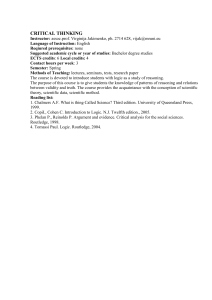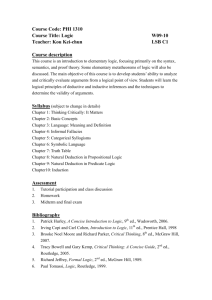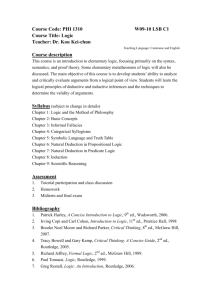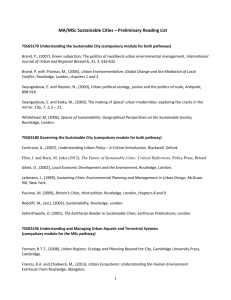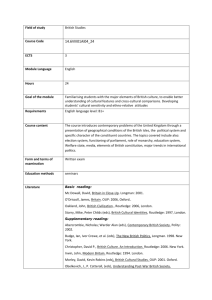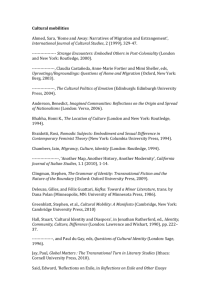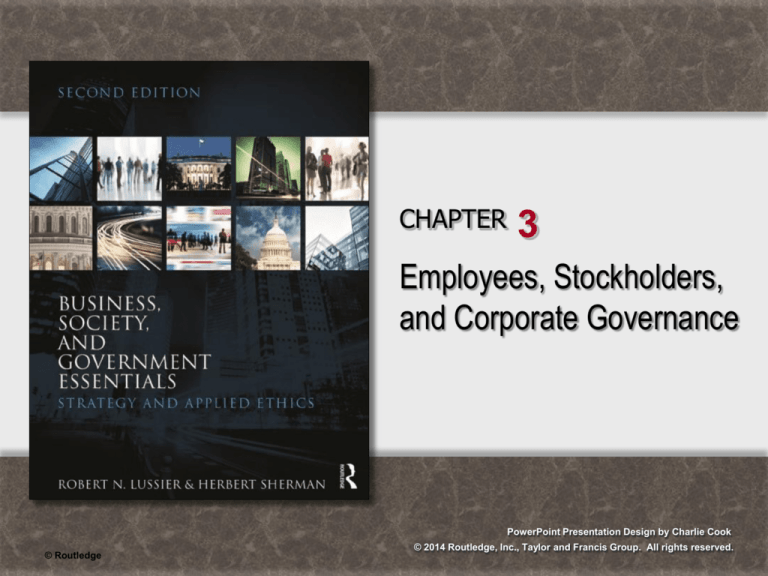
CHAPTER
3
Employees, Stockholders,
and Corporate Governance
PowerPoint Presentation Design by Charlie Cook
© Routledge
© 2014 Routledge, Inc., Taylor and Francis Group. All rights reserved.
Learning Outcomes
After studying this chapter, you should be able to:
1. Analyze old and new employment relationship differences
2. Compare and contrast employment contracts in union and nonunion
organizations
3. List and briefly describe six employee rights, in addition to organizing
and collective bargaining
4. Compare and contrast mediators, arbitrators, and ombuds
5. Define corporate stakeholders and describe their primary power
6. Explain how the government helps to protect stockholders
7. Differentiate between inside and outside members of the board of
directors and the potential problem of insiders
8. Define the key terms in this chapter
© Routledge
Employer–Employee Relations
Why People Work
Wages and
benefits
© Routledge
Social
needs
Sense of
self-worth
Employer–Employee Relations (cont’d)
Employer–Employee
Relationship
Performance
of the
business
© Routledge
Stakeholders
and
competitors
Society and
government
The New Employment Relationship
The Social Contract
Expectations
© Routledge
Rights
Duties
Figure 3.1
From the Old to the New Employment Relationship
Old Employment Relationship
New Employment Relationship
Getting a job and being trained to do
the work, with continual company
training to update your skills
Getting the job based on current skills and
experience, and being responsible for
updating your own skills
Job security, believing the firm will take
care of you professionally
Job at risk, knowing layoffs are always a
possibility and that you are responsible
for your career future
Good opportunities for advancement
within the firm
Fewer opportunities for advancement
within firm, with more opportunities
elsewhere
Long-term employment, with one
employer and career
Short-term employment and contract
workers, with multiple jobs and careers
Loyalty to and identification with
employer
Loyalty to self and identification with
profession
Steady pay increases with good
benefits, especially retirement
benefits or pension
Pay based on performance with fewer
benefits
Management versus labor
adversarial relations
Management and labor collaborative
relations
© Routledge
Management and Unions: Labor Relations
Labor
unions
• Represent their members’ special interests with
employers through collective bargaining to
establish employment contract governing
wages and benefits, work hours and
conditions, job security and other issues.
• Have been on the decline since the 1950s.
• Can use the labor strike as a powerful strategic
action to get what it wants during negotiations.
Management–Labor Union Collaboration
Is required to compete in the global economy,
rather than fighting among themselves.
© Routledge
Figure 3.2
Labor Legislation
The Norris-LaGuardia Act (1932) The act made the yellow dog contract illegal. Until 1932, employers could require employees to
sign a yellow dog contract, which stated that as a condition of employment the employee would
not join a union or engage in union activities. If the employee did, he or she was legally fired.
The Wagner Act
(also known as the National
Labor Relations Act, 1935)
and the NLRB
The act gave employees the right to unionize without fear of prosecution, and it listed unfair
practices of employers. Section 7 states: “Employees shall have the right to self-organize, to
form, join or assist labor organizations, to bargain collectively through representatives of their
own choosing, and to engage in concerted activities for the purpose of collective bargaining or
other mutual aid and protection.” The Wagner Act also established the National Labor
Relations Board (NLRB). The purpose of the NLRB is to enforce the provisions of the Wagner
Act and to conduct elections to determine whether employees will unionize and who will be
their representative in collective bargaining.
The Fair Standards Act (1938)
The act established minimum wages. As of January 1, 2012, the federal minimum rate
was $7.25, but the state minimums can be higher, such as in Oregon and Washington.
The Taft-Hartley Act (1947)
Through the Wagner Act, union membership grew as did union power. In fact, unions
became so powerful that the Taft-Hartley Act was passed to offset some of the imbalance
of power between labor and management. It amended the Wagner Act to include a list of
unfair practices by unions.
The Landrum-Griffin Act
(also known as the Labor
Management Reporting and
Disclosure Act, 1959)
The act was passed to protect union members from corrupt or discriminatory union activities,
as it required regulation of internal union affairs. Unions are still having some problems. For
example, Teamster President Ron Carey was investigated for fundraising abuses in his
reelection campaign.
The Worker Adjustment and
Retraining Notification Act
(WARN) of 1988
WARN requires employers with a 100 or more employees to give 60 days advanced
notice of plant closings or mass layoffs of their employees.
© Routledge
Figure 3.3
Union Organizing
© Routledge
Collective Bargaining and Government Help
National Labor
Relations Board
(NLRB)
Oversees the union organizing, and election,
and certification process to ensure that unions
and employers comply with the various labor
relations laws .
Federal Mediation
and Conciliation
Service (FMCS)
Serves as a neutral third party to assist in the
collective bargaining process.
Mediator
Is a neutral party who helps management and
labor settle their disagreements.
Arbitrator
Is a neutral party who makes a binding decision
that must be followed by management and
labor.
© Routledge
Employee Job Security Rights
Employment-at- Holds that the employment relationship is
Will Doctrine
voluntary and that employees can be fired
or quit for any or no reason.
Due Process
Is the employee’s right to be treated fairly
and to receive an impartial review of a
complaint.
Ombuds
Investigates employee complaints and
helps to settle them fairly.
Grievance
committees
Hear complaints, somewhat like a court of
peers, managers, or a mix of both.
© Routledge
Employee Rights in the Workplace
Privacy
Rights
Safety and
Health
Health Care
Workplace
Violence
© Routledge
Workplace
Rights Issues
Substance and
Honesty Tests
Freedom of Speech
and Whistleblowing
Stockholders: Classification and Objectives
Individuals
Stockholders
Capital
Appreciation
© Routledge
Institutions
Dividends
Figure 3.4
Corporate Power Stakeholders
Stockholders
(owners)
Board of Directors
(overseers)
Management
(controllers)
Employees
(workers)
© Routledge
Figure 3.5
Stockholder Rights
To share in the profits through dividend payments, when and if
declared by the board of directors
To sell their shares of stock
To vote on:
Board of director members
Major mergers and acquisitions
Bylaw and charter changes
Stockholder proposals
To know about the affairs of the corporation through information
transparency and disclosure
To receive an annual report with financial performance and condition
To take the corporation and its officers to court through stockholder
lawsuits
© Routledge
Corporate Structure
Corporate
charter
Is granted by the state giving the firm the
right to operate under basic terms of its
existence and governance.
Stockholders
Are legal owners who elect the corporate
board of directors.
Board of
directors
Oversee strategic direction and provide
governance for upper management actions.
Managers
Plan, organize, lead, and control firm
resources to achieve corporate goals.
Employees
Work to provide the corporation’s products
and perform other functions.
© Routledge
Protection of Stockholder Rights
Security and • Is the primary government agency protector
Exchange
of publicly traded stockholder rights.
Commission • Requires full disclosure of vital company
(SEC)
information to shareholders.
• Regulates use of confidential information to
prevent insider trading.
SarbanesOxley Act
of 2002
© Routledge
• Mandated reform of corporate governance
to enhance corporate responsibility for
financial and accounting fraud.
• Created the Public Company Accounting
Oversight Board (PCAOB) to oversee the
activities of the auditing profession.
Figure 3.6 Sarbanes-Oxley Act of 2002: Reforming Corporate Governance
Stockholders
Requires shareholders’ vote to approve stock option plans
Managers
Requires full disclosure of complex financial transactions and
changes in firm financial conditions “in plain English”
Requires executives to disclose stock sales within two days
Requires CEOs and CFOs to give written certification of the truth of
corporate financial statements, with the possible penalty of jail for 20
years and $5 million in fines for falsification
Requires executives to pay back any bonuses or profits from stocks
received based on financial reports that had to be changed at a later
date
Prohibits the firm from giving personal loans to managers
Prohibits executives from making stock transactions when employee
pension blackouts prohibit employee stock transactions
© Routledge
Figure 3.6 Sarbanes-Oxley Act of 2002: Reforming Corporate Governance
Boards of Directors
Requires the majority of board members to be outside directors, not
employees
Requires at least one financial expert be a member of the corporate
audit committee
Requires the audit committee to approve the selection of auditors,
auditor consulting contracts, and 401(k) plans
Outside Auditors
Requires the establishment of an independent board to oversee the
audit of public corporations
Prohibits accounting firms from providing auditing and other services
that would create conflicts of interest, thereby limiting consulting
work
Requires the rotation of the lead outside auditor firm every five years
© Routledge
Shareholder Activism
Activists in Action
Shareholder
resolutions
© Routledge
Annual
meetings
Public
pressure
Corporate Governance:
A System of Checks and Balances
Stockholders
Board of
Directors
© Routledge
Managers
The Board of Directors:
Responsibilities and Composition
• Establish and enforce governance control by:
Setting corporate objectives
Developing strategies and policies
Selecting top managers to achieve objectives and
strategies (and removing them when necessary)
Setting executive employee compensation
• Structure of the board:
Inside directors
Outside directors
Committees
© Routledge
Typical Corporate Committees
Executive
Committee
Audit
Committee
Public Policy
Committee
© Routledge
Compensation
Committee
Nominating
Committee
Executive Employee Compensation
Stock Options
Salary
Benefits
Bonuses
© Routledge
Executive
Compensation
Factors
Personal Perks
Retirement and
Golden Parachutes
Nonmarket and Market Strategies and Ethics
Strategies for
coalition
building with
board of
directors
Strategies to
build ethical
information
communication
Strategies
emphasizing
social
responsibility
Firm
Performance
Benefits
© Routledge
Information and Action Strategies
for Dealing with Union Activists
• Management can resist unionization by:
Holding mandatory and one-on-one meetings with
employees to present their side
Using management consultants to stop unionization
Distributing antiunion leaflets
Mailing antiunion letters
Using antiunion videos
Using striker replacement workers
Subcontracting work overseas
© Routledge
Information and Action Strategies
for Dealing with Stockholder Activists
• Management can deal with activists by:
Ignoring and opposing activists when activist power of
ownership is weak.
Negotiating with activists when activist power of
ownership is strong.
Using a poison pill strategy to make the cost of a
hostile takeover too expensive for the activists to
attempt.
© Routledge
Using Political and Legal Strategies
to Avoid Employee Rights Lawsuits
• Management can avoid employee lawsuits by:
Using ethical HR policies that promote diversity.
Offering family-friendly workplaces with flexible
benefits and working hours, and using telecommuting
to help employees balance work and family life.
Cooperating with employees seeking the benefits of
the Family and Medical Leave Act.
Offering employee assistance programs (EAPs).
Working with OSHA to set reasonable safety and
health standards.
© Routledge
Effective Corporate Governance Strategies
• Take a stakeholder approach to governance by:
Paying executives an ethical and fair compensation
based on performance, and fully disclosing the entire
package.
Not allowing the CEO and chairman of the board
positions to be held by the same individual.
Setting limitations on the number of inside directors
and CEO power to nominate candidates to the board.
Encouraging the nomination of multiple candidates for
each director position to give stockholders more
choices when voting.
© Routledge
Key Terms
arbitrators
insider trading
boards of directors
labor unions
collective bargaining
mediator
corporate charter
ombuds
corporate governance
privacy rights
due process
Sarbanes-Oxley Act
employee rights
shareholder resolutions
employment-at-will
stockholders
employment relationship
stock option
inside directors
whistleblowing
© Routledge


